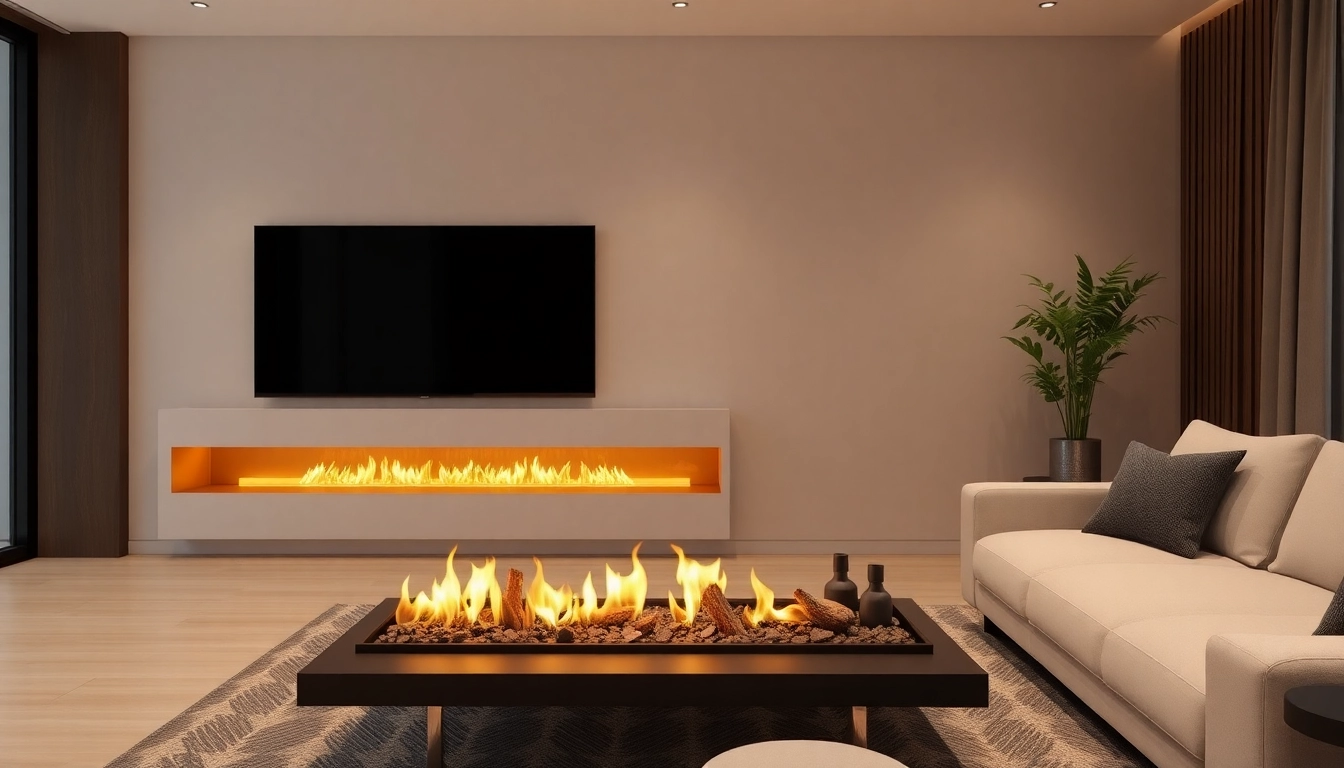Understanding Automatic Bioethanol Fireplaces
What is an Automatic Bioethanol Fireplace?
An automatic bioethanol fireplace is an innovative heating solution that uses bioethanol fuel to create a flame. These fireplaces are designed for ease of use and operate on a simple principle: burn bioethanol to produce warmth and ambiance without the need for traditional fuel sources like wood or natural gas. Unlike traditional options, this modern alternative offers a cleaner-burning solution with minimal emissions, making it an attractive choice for both aesthetics and environmental concerns. An automatic bioethanol fireplace can be remotely controlled, allowing users to adjust the flame intensity and turn the unit on or off from a distance, enhancing convenience and safety.
How Do They Work?
Automatic bioethanol fireplaces function through a series of advanced features. At their core, they employ a bioethanol burner that ignites when fueled with liquid bioethanol—a renewable energy source derived from plant materials. The system includes an electronic ignition mechanism which ensures a safe and easy start-up with the push of a button. Moreover, many models now come equipped with thermodynamic sensors to adjust flame levels based on ambient temperature, thereby improving efficiency and safety.
The fuel tank within the fireplace holds the bioethanol, which is automatically dispensed as needed for flame generation. This feature requires minimal user intervention, making it an excellent choice for those who prefer a hassle-free experience. Some models incorporate user-interface touch screens or smartphone applications that allow for even greater control over the fireplace’s settings, providing a seamless integration into smart home systems.
Benefits of Choosing Automation
The benefits of opting for an automatic bioethanol fireplace extend beyond mere convenience. Among the primary advantages are:
- Convenience: Remote control or app functionality allows users to ignite and control their fireplace without manual effort.
- Safety: Automatic shut-off features ensure that the fireplace turns off if it overheats or if there are any malfunctions.
- Efficient Fuel Use: Automated systems can optimize fuel consumption, using only what is necessary to maintain the desired flame height.
- Clean and Eco-Friendly: Bioethanol is a renewable resource, and burning it produces no smoke, soot, or ash, providing a cleaner alternative to traditional fireplaces.
Key Features of Automatic Bioethanol Fireplaces
Safety Mechanisms and Sensors
Safety is paramount in the design of automatic bioethanol fireplaces. These units are equipped with a variety of safety mechanisms that include:
- Flame Sensors: These sensors detect the presence of flames and can automatically extinguish the fire if it exceeds safe levels.
- Overheat Protection: If the temperature within the fireplace becomes too high, the system will shut off the fuel supply to prevent risks of fires.
- CO2 Detectors: Some models feature carbon dioxide detectors, which alert users if harmful gases are present.
These essential features position automatic bioethanol fireplaces as one of the safest options available, particularly in homes with children or pets.
Remote Control Options
The integration of remote control technology into bioethanol fireplaces represents a significant shift in user experience. Homeowners can control their units from a distance using handheld remotes, mobile applications, or even voice commands through smart home systems like Amazon Alexa or Google Home.
This level of accessibility not only enhances user enjoyment but also allows for greater customization of the fireplace experience, including adjusting flame size and heat output based on user preference and room conditions.
Design and Aesthetic Considerations
Automatic bioethanol fireplaces come in various designs that cater to different styles and preferences. Manufacturers are increasingly focused on aesthetics, producing units that can seamlessly integrate into modern interiors or serve as statement pieces. Options range from sleek and minimalist designs to more intricate styles that feature glass and metal finishes.
Moreover, these fireplaces can be installed in various settings, from urban apartments to rustic cabins, giving homeowners greater flexibility in decor choices. Many models offer customization options, including different colors, materials, and sizes to fit the unique needs of any space.
Comparing Automatic vs. Traditional Bioethanol Fireplaces
Efficiency and Performance Differences
When comparing automatic bioethanol fireplaces to traditional models, efficiency and performance stand out. Automatic units typically utilize advanced technology that ensures more efficient burning of fuel, leading to consistent flames with lower fuel consumption. Traditional models, while still functional, often require manual adjustments and monitoring, leading to less efficient operation.
Additionally, automatic models can provide real-time feedback on performance, such as fuel levels and flame status, allowing users to manage their heating needs more effectively.
Installation Considerations
Installation requirements also differ between automatic and traditional bioethanol fireplaces. Automatic fireplaces often have simpler installation processes due to their vent-free design. They do not require chimney or flue systems, meaning they can be installed in a wider range of locations without extensive renovation.
Conversely, traditional bioethanol fireplaces may need additional considerations regarding installation, particularly if they mimic more conventional fireplaces. Homeowners should always consult the manufacturer’s guidelines regarding installation specifics tailored to their chosen model.
Cost Analysis: Initial and Long-term Expenses
The initial cost of purchasing an automatic bioethanol fireplace can be higher than that of a traditional model due to the added technology and features. However, long-term operational costs may favor automatic models. With efficient fuel use and lower maintenance requirements, automatic units can save homeowners money in the long run.
Fuel costs for bioethanol should also be considered. While bioethanol prices fluctuate, they typically remain competitive with electricity costs when calculated per hour of use. Homeowners should evaluate their specific needs when deciding between automatic and traditional fireplaces to ensure they make a knowledgeable financial investment.
Choosing the Right Automatic Bioethanol Fireplace for Your Home
Styles and Sizes to Fit Your Space
Selection is key when it comes to finding the right automatic bioethanol fireplace for your home. Considerations include the size of the space where the fireplace will be installed, the desired heat output, and the overall style you wish to achieve. Fireplaces are available in multiple formats, from wall-mounted to freestanding units, allowing for flexibility based on room layout.
It is essential to assess room dimensions and aesthetics before making a selection to ensure that the fireplace complements rather than detracts from your existing decor.
Top Brands and Models
Several brands stand out in the automatic bioethanol fireplace market noted for their quality, design, and safety features. Brands such as AFIRE, Planika, and Astral are well-regarded and known for their innovative approaches to combustion and smart home integration.
Each brand brings its unique offerings, catering to a range of preferences and requirements. Researching and comparing specific models based on user experiences and reviews will lead to a more informed choice.
Customer Reviews and Feedback
Customer reviews are invaluable in the decision-making process. Prospective buyers should take the time to read feedback on specific fireplace models, considering ease of use, aesthetic appeal, and performance reports. Common themes in customer reviews often highlight the efficiency, safety features, and ease of installation.
Engaging with online forums or social media groups dedicated to home improvement can also yield insights from homeowners who have experience with particular models. Gathering various perspectives can assist in selecting the correct fireplace tailored to personal needs.
Maintenance and Safety Tips
Regular Maintenance Practices
While automatic bioethanol fireplaces are generally low-maintenance, routine checks are necessary to ensure optimal performance and safety. Regular tasks include:
- Checking fuel levels and refilling as necessary to maintain consistent operation.
- Inspecting the burner for residue build-up that may disrupt combustion.
- Cleansing glass panels to keep the fireplace looking its best.
Following the manufacturer’s maintenance schedule will prolong the life of the fireplace and enhance safety while in use.
Ensuring Safe Operation
Ensuring safe operation goes hand in hand with maintenance. It is essential for users to familiarize themselves with the fireplace’s safety features and mechanisms. Adhering to safety guidelines, such as not leaving the fireplace unattended when in use and avoiding flammable materials nearby, is critical for safe enjoyment.
Educating all household members on the correct operating procedures, including how to use the remote or app control, hazards to avoid, and the importance of following safety instructions when refueling, is essential for a safe environment.
Common Troubleshooting Techniques
Users may encounter occasional issues with their automatic bioethanol fireplaces. Common troubleshooting techniques include:
- Resetting the system if operational issues occur—often a simple power cycle can resolve minor glitches.
- Ensuring the fuel container is filled properly without any blockages in the dispensing system, which ensures optimal flame generation.
- Consulting the user manual for troubleshooting tips specific to the model can assist in addressing various performance contexts.
If problems persist, reaching out to customer support or qualified technicians may be necessary to resolve more complex issues safely.



